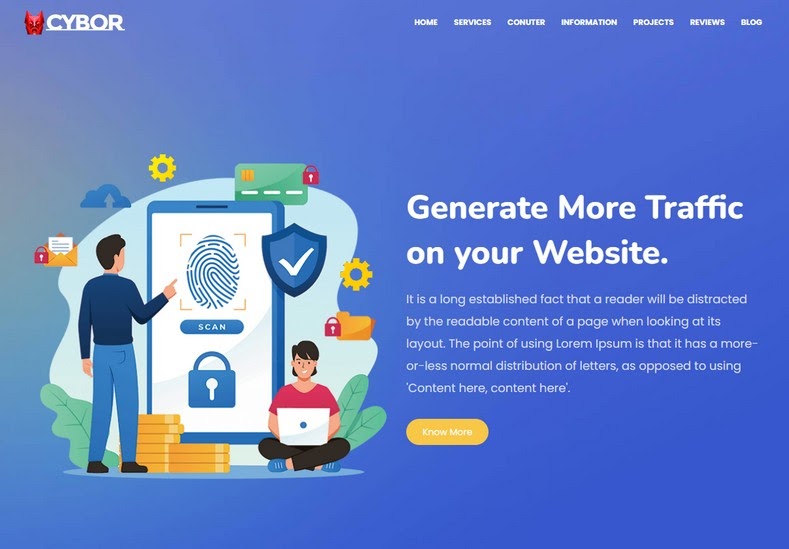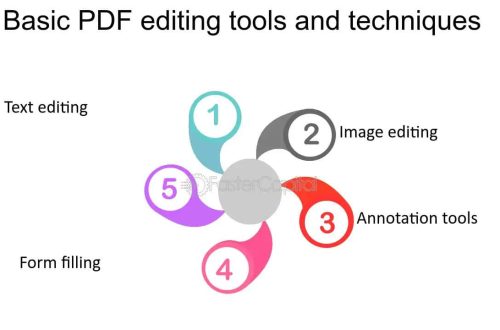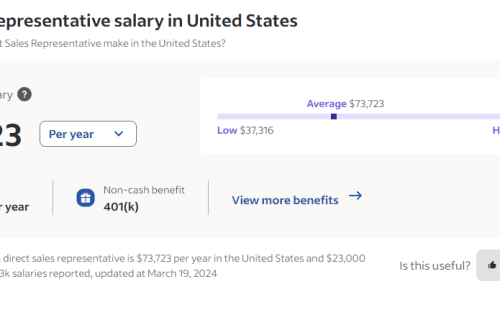Itching to start writing your next blog post but not sure what to blog about? We’ve got you covered.
In this post, you’ll find 14 excellent blog post ideas that are sure to get your creative cogs whirring.
These are the types of posts that are proven to get more clicks, engagements, and shares.
Quick note before we get started: All the blogging ideas in the list below will work for any niche. If you haven’t chosen your blogging niche yet, start here instead.
Ready? Let’s get started!
1. How-to posts
How-to posts are educational, informative posts that show your readers how to do something. It’s a format that makes sense for pretty much any niche.
Here are some examples:
- Fashion blog – “How to choose a wardrobe color palette”
- Fitness blog – “How to lose fat and gain muscle at the same time”
- Personal finance blog – “How to plan for your retirement”
These types of posts make great pieces of evergreen content and should be a core part of your content mix no matter what type of blog you’re running.
One way to generate ideas for “how to” posts that your target readers will be interested in is to use Google suggestions. Here’s how.
First, type “how to” into the Google search bar. Then, add a broad keyword that’s relevant to your niche.
For example, if you’re starting a blog focused on graphic design, you’d type in “how to graphic design”. Then, look at the search suggestions that Google throws up for ideas:
This is a good place to start but remember that these keywords are likely to be very competitive, so it’s best to use them as a jumping-off point. Try to think outside of the box and brainstorm some more specific, less competitive ‘how to’ post titles that your competitors might have missed.
Example
Some of our most popular articles here at Blogging Wizard are how-to posts, like this one:
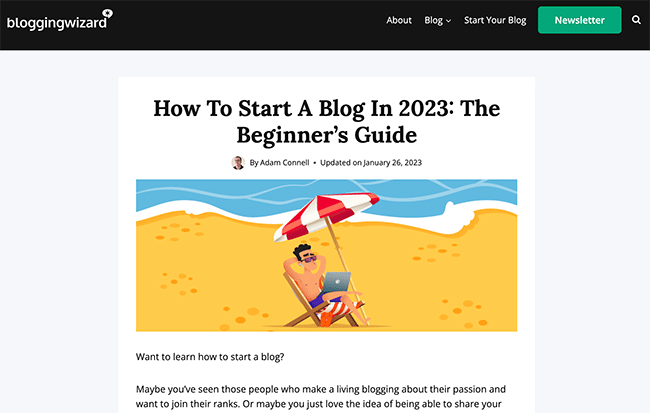
Here, we’ve broken up the process of how to start a blog into a simple 11-step guide that anyone can follow. And it’s brought us a ton of traffic.
2. Listicles
Listicles are blog posts that are presented in the form of a list (think BuzzFeed articles). They typically have numbers in the title, like:
- “21 Tweets that will restore your faith in humanity”
- “15 reasons you should cut down on meat”
- “10 times Jenniffer Lawrence killed it on the red carpet”
You’ve probably read a bunch of these types of articles already—they’re one of the most popular content formats on the web. And for good reason.
The thing is, Listicles tend to perform really well.
Because they’re split into snackable sub-sections, they’re super easy to read. And as a result, they tend to get more clicks, better on-page signals, and more shares.
But don’t take our word for it, just look at the statistics. 36{da0bf9cd17a63b06d0145198c6e4d1da153467364e5d59fe12aeae2db138af5a} of readers prefer blog headlines that have a number in the title (i.e., listicles). That’s more than any other type of headline.
Example
BuzzFeed is the king of listicles. Here’s one of their most recent trending posts that’s written in a listicle format:

A lot of BuzzFeed listicles are in the pop culture sphere, but the format works for pretty much any niche. Just think about what type of list content would resonate with your audience.
3. Response posts
Response posts are blog posts that answer—or respond to— a specific question. Because they focus on very narrow topics, they tend to be shorter than other types of posts (around 1,000 words or so).
The great thing about response posts is that they allow you to target very specific, longtail keywords that are less competitive but still have a good search volume.
So they stand a better chance of ranking in the search engine results pages (SERPs) and getting organic traffic.
The best way to come up with ideas for your response post is to use a keyword research tool, especially tools that generate a list of questions like QuestionDB or AnswerThePublic.
Example
We’ve published a bunch of these posts over the years. Here’s an example:
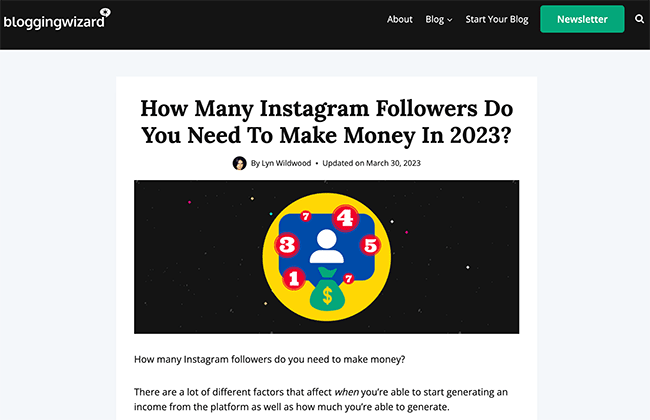
In this post, we answer a super specific question: “How many Instagram followers do you need to make money?”.
Because we targeted a long-string keyword and wrote a laser-targeted, SEO-optimized article on the topic, we now rank on page one of Google for that search query.
4. Opinion posts
Opinion posts are exactly what it says on the tin—blog posts where you share your opinion about something.
These types of posts are great for beginner bloggers as you’re just sharing your thoughts. There’s little to no research required so you should be able to write up an opinion post very quickly.
Opinion posts also have a lot of viral potential—especially if you have a unique hot take on a polarizing topic that’s bound to get people talking.
Example
Here’s an opinion post published on the Voices section of the Independent.
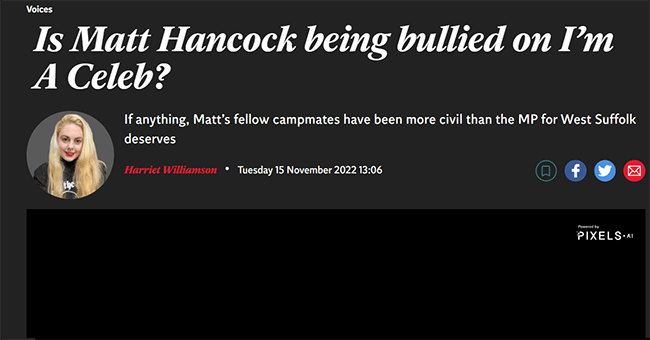
The writer has focused on a trending topic that was polarizing public opinion at the time of writing and offered her take on it. As intended, it successfully got people talking and had plenty of comments.
5. Original research
Original research posts are blog posts in which you share the results of a study, survey, or analysis that you’ve performed.
What’s great about these types of posts is that they can earn you hundreds of backlinks.
Other bloggers and journalists might use your data in their posts, and when they do, they’ll typically credit you as the source with a link to your post.
Not only can this drive more traffic to your blog, but it can also help to boost your domain authority and off-page SEO so that you stand a better chance of ranking for your target keywords in the future.
Example
In our roundup of the best-selling items on eBay, we incorporated our own original research by including metrics like sell-through rate (STR), average prices, and successful listings.
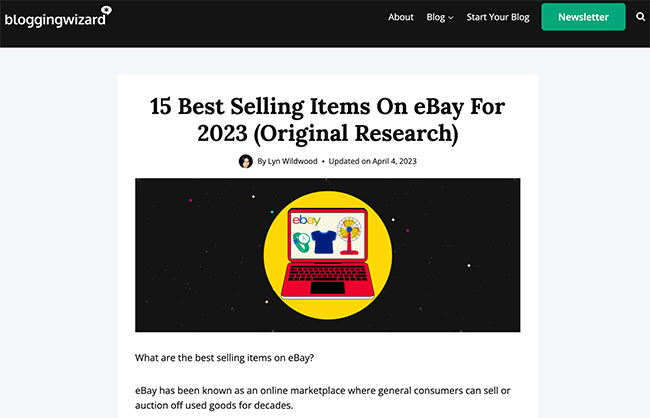
Offering original research made the post data-driven, which helped differentiate it from our competitors and add value for our readers.
6. Product reviews
Product review posts are great because they’re easy to monetize—and they make sense for pretty much every blog niche.
Just pick a popular product related to the topic of your blog and review it. For example, if you’re running a blog about health and fitness, you might write a review of different protein powders, supplements, or gym equipment. Product review blogs are also good for lifestyle blogs that recommend products for the home.
Once you’ve written your reviews, you can sign up for an affiliate program and add your affiliate links to your reviews. That way, if you give the product a stellar review, you can invite readers to purchase it through your link and earn a commission when they do.
Or if you give it a poor review, you can suggest some alternatives that you’re an affiliate for.
Example
Here’s a great example of a product review post from Startup Bonsai.
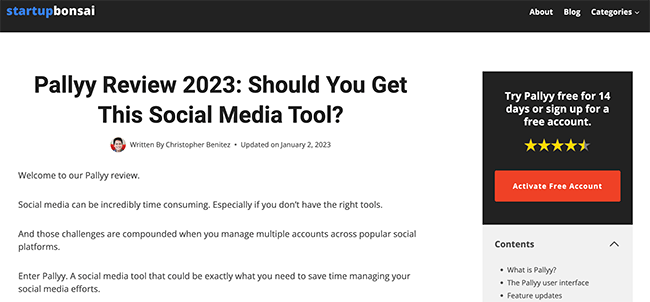
This is a review of Pallyy, a social media tool. But Startup Bonsai also has dozens of other software reviews for different marketing tools and platforms.
7. Versus posts
Versus posts are blog posts that include the term “vs” in the title. They compare two products head to head to see which is best and highlight the differences between them.
It’s very similar to a product review post, but instead of optimizing your content around ‘[product A] review’ keywords, you’ll be optimizing them around ‘[product A] vs [product B]’ keywords, which tend to be much less competitive.
Example
Here’s another example from BloggingWizard: Teachable vs Thinkific.
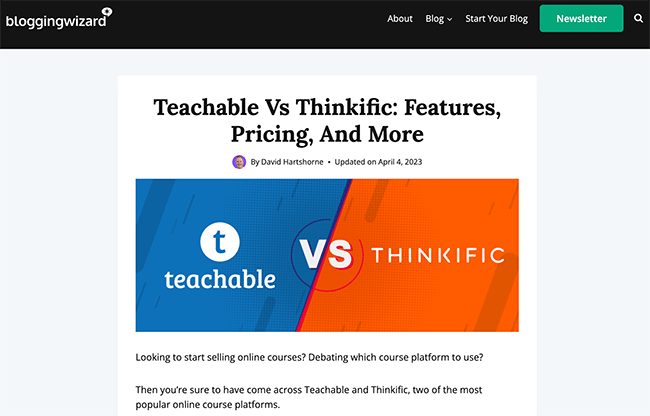
In this post, we compare two of the most popular online course platforms head to head to see which is best and look at their similarities and differences. It ranks on page one of Google for the target keyword.
8. Beginner guides
Beginner guides are exactly what you think they are—in-depth guides that introduce readers to a certain topic.
They’re another type of popular educational content and are similar to how-to posts, but aim for broad coverage of a topic rather than offering step-by-step instructions.
And they make the perfect first blog post as you can use them as a pillar post through which you add internal links to future posts that go more in-depth about specific subtopics.
Example
Our beginner-friendly guide to influencer marketing ranks in the top spot on Google for the keyword “influencer marketing beginner guide”.
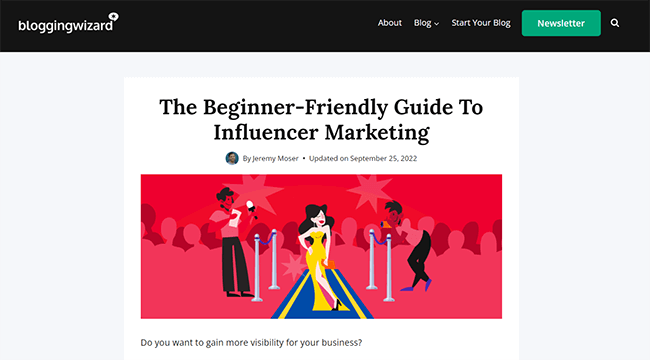
It offers a comprehensive introduction to what influencer marketing is and why it’s important. And it covers all the main topics beginners need to know, like how to find influencers, how to reach out to them, etc.
9. Ultimate guides
Ultimate guides are similar to beginner guides. The difference is that while the latter focuses on offering a broad introduction to a topic, ultimate guides aim for complete in-depth coverage of everything you need to know.
Ultimate guides are typically super long. Be prepared to write 5,000 – 10,000 words or more, depending on the topic.
They’re a lot of work to create, but they’re also very valuable pieces of blog content. They act like link magnets, can boost your topical authority, and help establish you as a thought leader in your niche.
Example
HubSpot’s ultimate guide to SEO is a mammoth post that covers all the most important things you need to know about search engine optimization.

The article goes into detail about everything from ranking factors to building an SEO strategy, measuring results, and more.
10. Trending news stories
Trending news stories can also be good blog topics. They’re interesting, relevant, and have good shareable potential.
What’s great about this method is that you never run out of things to blog about, because there’s almost always a new story that’s worth giving your hot take on.
A good way to find news stories to write about is to monitor hashtags related to your niche on social media sites like Twitter. However, be sure to get your content produced and posted quickly so that it’s still relevant when you post it.
If you want more tips about this, here’s a guide to monitoring trends and writing newsworthy content
Example
One of the best news-related blogs in the SEO space is Search Engine Land.

Almost all of their content focuses on the newest updates in the SEO world, and the site has become a hub for marketers and businesses alike.
11. Interviews
Interviews can be a really popular blog topic, and they have great shareable potential too. You can really interview anybody for an interview post, from the CEO of your company to a customer or an influencer related to your niche.
The key to interview posts is to provide insight that will really hook the reader. They don’t want to know your interviewee’s favorite color, so make sure you spend some time planning your questions so that your readers will learn something new and useful from the interview.
Example
The blog Breakthrough Master regularly interviews CEOs from businesses in the local area. Here’s one example:
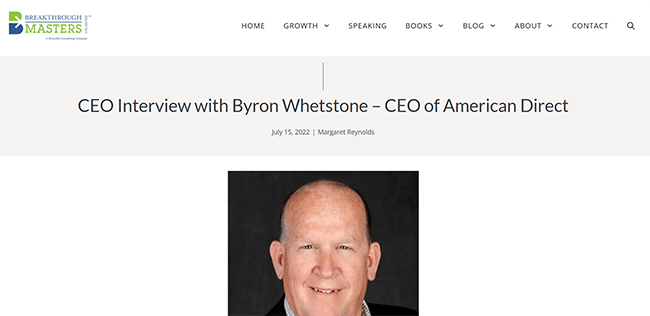
The posts include some hard-hitting questions and detailed answers that really add value for readers.
12. Ego-bait content
Ego-bait content refers to blog posts that are designed to generate backlinks and shares for your website by stroking the ego of influencers and other bloggers in your niche.
Here’s how to create these types of posts.
First, use an influencer marketing research tool like BuzzStream to find the most popular influencers, bloggers, and thought leaders in your space.
Then, write a post in which you list a roundup of the biggest and best bloggers in your industry and include them in it.
For example, let’s say you’re running a blog about marketing. You could write a blog post on “the best marketing blogs to follow in 2022”.
Once you’ve published the post, reach out to the people that you gave a shout-out to and let them know. Hopefully, they’ll share the post with their audience, thus driving traffic and earning you a powerful backlink.
You can use blogger outreach tools to help with both the prospecting and outreach steps.
Example
Here’s a great example of ego-bait content from Nomadic Matt. In this post, he lists his list of favorite travel blogs and includes many of his biggest competitors.
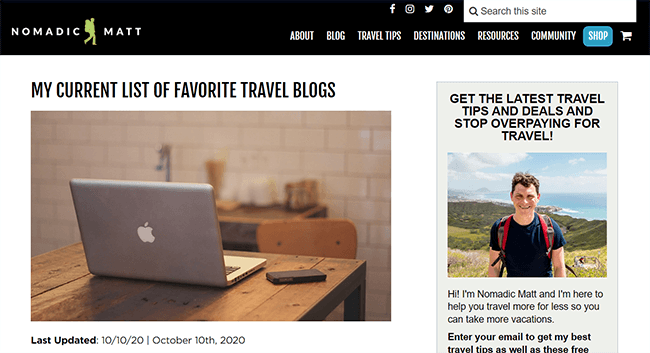
Once he’d published it, he could have easily reached out to his competitors to let them know about the post and in the process, build valuable relationships and earn free promotion.
13. Tips & tricks
Sharing your insider knowledge is another great way to write a high-ranking blog post. Tips and tricks blogs are extremely popular and useful making them a big hit with blog audiences.
What’s great about this idea is that it really is applicable to any niche. You can share tips and tricks about absolutely anything whether you’re a mom blog, food blog, or lifestyle blog, the possibilities are endless.
If you want your tips and tricks articles to be a success, try to share original tips that aren’t mentioned in competitor articles, and this can help you stand out from the crowd.
Example
Here at Blogging Wizard, we love to share tips and tricks about blogging. Here’s one of our most recent posts about smart tips for bloggers:
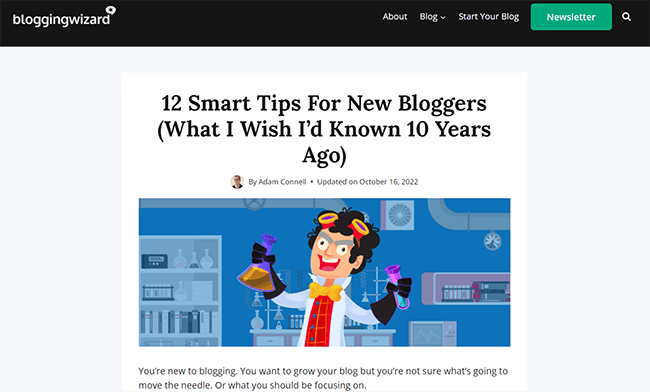
As you can see, the tips listed are actionable and insightful, and they include original ideas that we’ve learned along our blogging journey, not just regurgitated information from competitor articles.
14. FAQ posts
If you’re selling a product or service on your website, then your customers and audience may have a lot of questions. One of the best ways to populate your blog, and address your audience’s queries is to write an FAQ post.
FAQ stands for frequently asked questions, and an FAQ post can be a really useful addition to your blog.
They’re quick to write. And for businesses, they’re likely to save you a lot of time when it comes to customer support. You can work out what your customers are asking based on previous questions you’ve received or by using a keyword research tool like Answer the Public.
Example
Some websites create interactive help pages for FAQs but you can also present them in the form of a blog post just as thealist.me has done here:
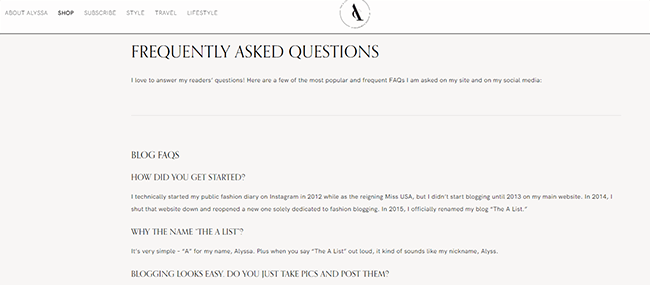
This strategy allows you to zoom in and answer questions on specific topics rather than just addressing general questions about your business.
Final thoughts
That concludes our roundup of blog post ideas. Hopefully, this has given you some ideas of what to blog about.
But remember, these are just ideas for some popular blog post formats, to help you get started. Ultimately, you should write posts about topics you know about and that will resonate with your target audience.
The best way to come up with blog post topics is through careful and considered keyword research. You can learn how to get started with keyword research here.
The reason we recommend this approach is because it increases the chances of gaining long-term residual traffic from search engines like Google.
Good luck!
Disclosure: This post contains affiliate links. This means we may make a small commission if you make a purchase.


